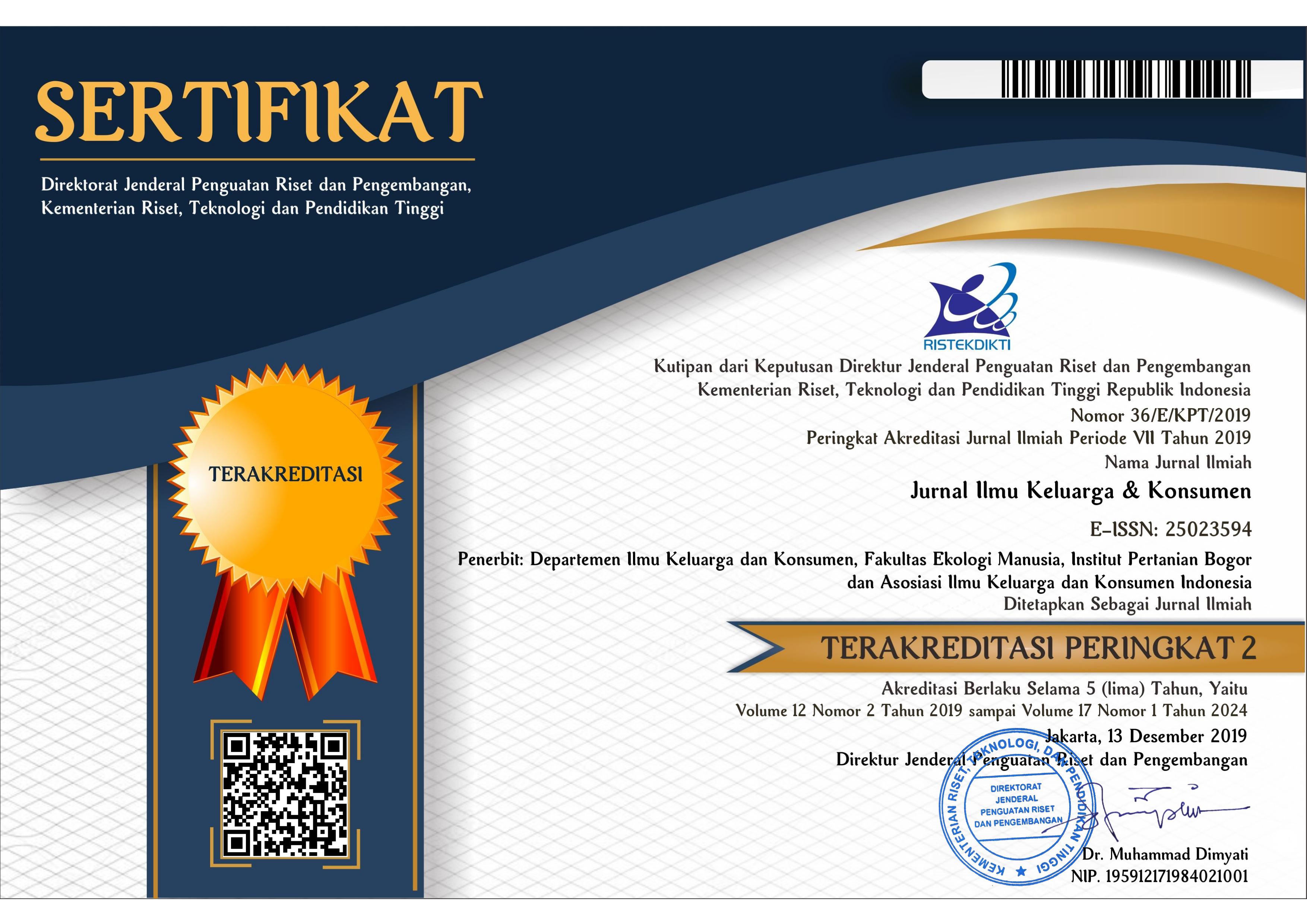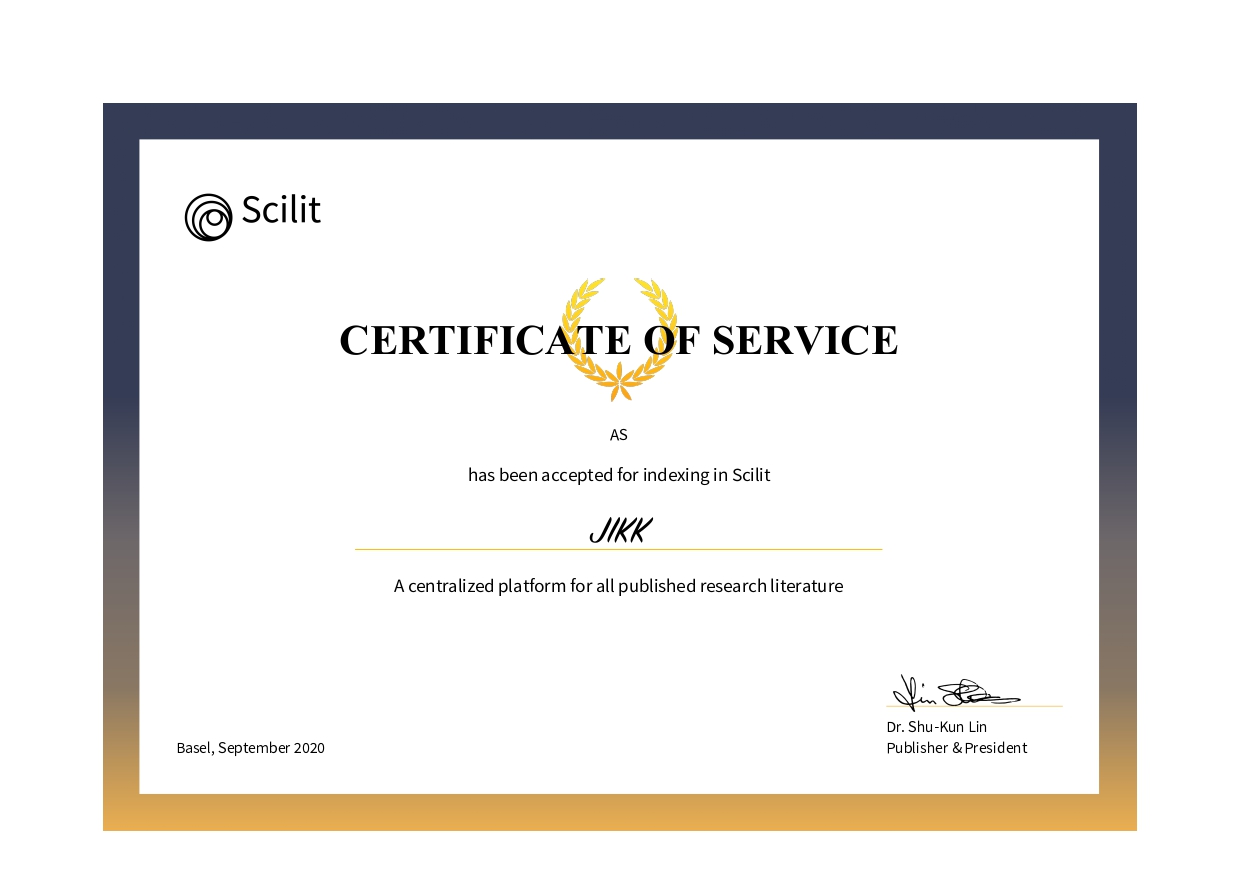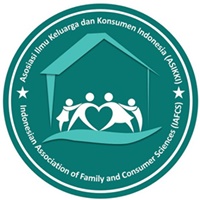Pengaruh Interaksi Remaja dengan Keluarga dan Teman serta Self-Esteem terhadap Perilaku Prososial Remaja Awal
Abstract
Adolescent tend to do the anti-social behavior, so it needs prevention step by developing prosocial behavior. This
study aimed to analyze the effect of characteristic, family interaction, friend interaction and self-esteem on
prosocial behavior among early adolescents. This research was a cross-sectional study. The location of the
research was conducted in Junior High School X in Bogor District which was chosen purposively. The examples
of this study were 200 adolescents with same sex siblings (100 girls and 100 boys) which was chosen by cluster
random sampling technique. The results showed that there was no significant difference in interaction with the
father between girls and boys. Closeness dimension of girl’s interaction with mother and girl’s interaction with a
friend were higher than boy’s. Closeness and discord dimensions of girl’s interactions with same-sex siblings
were higher than boy’s. Self-esteem didn’t have a significant difference between girls and boys, but girls were
more prosocial than boys. Closeness dimension of interaction with mother, interaction with the sibling, and
interaction with a friend also self-esteem can improve prosocial behavior, but interaction with father didn’t
significantly influence to prosocial behavior.
References
Afolabi, O. A. (2014). Do self esteem and family relations predict prosocial behaviour and social adjustment of fresh students?. Higher Education of Social Science. 7(1): 26-34. Diambil dari http://www.cscanada.net/index.php/hess/article/view/5127/pdf_55.
Barry, C. M., Wentzel, K. R. (2006). Friend influence on prosocial behavior: The role of motivational factors and friendship characteristics. Developmental Psychology. 42(1): 153–163. doi:10.1037/0012-1649.42.1.153
Benenson, J. F., Christakos, A. (2003). The greater fragility of females’ versus males’ closest same-sex friendships. Child Development. 74(4): 1123-1129. doi:10.1111/1467-8624.00596
Branje, S. J. T., Hale III, W. W., Frijns, T., Meeus, W. H. J. (2010). Longitudinal associations between perceived parent-child relationship quality and depressive symptoms in adolescence. Journal Abnormal Child Psychology. 2010 (38):751–763. doi:10.1007/s10802-010-9401-6
Burt, S. A., Donnellan, M. B., Iacono, W. G., McGue, M. (2011). Age-of-on set or behav ioral sub-types? a prospective comparison of two approaches to characterizing the heterogeneity within antisocial behavior. J Abnorm Child Psychol. 36: 633-644. doi:10.1007/s10802-011-9491-9.
Buist, K. L., Dekovic, M., Meeus, W., van Aken, M. A. G. (2002). Developmental patterns in adolescent attachment to mother, father and sibling. Journal of Youth and Adolescence. 31(3): 167–176. doi:10.1023/A:1015074701280
Caprara, G. V., Pastorelli, C. (1993). Early emotional instability, prosocial behaviour, and aggression: some methodological aspects. European Journal of Personality. 7(1):19-36. doi:10.1002/per.2410070103
Carlo, G., Randall, B. A. (2002). The development of a measure of prosocial behaviors for late adolescents. Journal of Youth and Adolescence. 31(1): 31-44. doi:10.1023/A:1014033032440.
Cole, A. K., Kerns, K. A. (2001). Perceptions of sibling qualities and activities of early adolescents. Journal of Early Adolescence. 21(2): 204-227. doi:10.1177/0272431601021002004
Doron, H., Sharabi-Nov, A. (2016). Siblinghood, gender, and families: are sisters more close and unified than brothers? The Family Journal: Counseling and Therapy for Couples and Families. 24(4):385-394. doi:10.1177/1066480716663174
Eisenberg, N., Miller, P. A., Schaller, M., Fabes, R.A., Fuitz, J., Shell, R., Shea, C. L. (1989). The role of symphaty and altruistic personality traits in helping: a reexamination. Journal of Personality. 57(1): 42-67. doi:10.1111/j.1467-6494.1989.tb00760.x
Eisenberg, N., Fabes, R. A., Spinrad, T. L. (2006). Prosocial development. In Damon W., Eisenberg, N. (Eds). Handbook of Child Psychology, Volume 3: Social, Emotional, and Personality Development (pp. 646–718). New York, NY: Wiley.
Fabes, R. A., Carlo, G., Kupanoff, K., Laible, D. (1999). Early adolescence and prosocial moral behavior I: the role of individual processes. Journal of Early Adolescence. 19(1): 5-16. doi:10.1177/0272431699019001001
Furman, N., Sibthorp, J. (2013). The development of prosocial behavior in adolescents: a mixed methods study from NOLS. Journal of Experiential Education. 20(10):1-16. doi:10.1177/1053825913489105
Furman, W., Buhrmester, D. 1985. Children's perceptions of the qualities of sibling relationships. Child Development. 56 (2): 448-461. Diambil dari http://citeseerx.ist.psu.edu/viewdoc/download?doi=10.1.1.852.8834&rep=rep1&type=pdf. [diunduh 30 Juni 2018]
Furman, W., Buhrmester D. (1992). Age and sex differences in perceptions of networks of personal relationship. Child Development. 63(1): 103-115. doi:10.1111/j.1467-8624.1992.tb03599.x
Hartup, W. W. (1989). Social relationship and their developmental significance. American Psychologist. 44(2): 120-126. doi:10.1037/0003-066X.44.2.120
He, JP., Burstein, M., Schmitz, A., Merikangas, K. R. (2013). The strengths and difficulties questionnaire (SDQ): the factor structure and scale validation in U.S. adolescents. J Abnorm Child Psychol. 41: 583-595. doi:10.1007/s10802-012-9696-6
Hurlock, E. B. (1999). Psikologi perkembangan: suatu pendekatan sepanjang rentang kehidupan: edisi kelima. Indonesia ID: Penerbit Erlangga.
Howe, L. (2002). Self-esteem in girls: does physical education make a difference? (Thesis). University of Lethbridge, Canada, Amerika Serikat.
Imuta, K., Henry, J. D., Slaughter, V., Selcuk, B., Ruffman, T. 2016. Theory of mind and prosocial behavior in childhood: a meta-analytic review. Developmental Psychology. 52(8):192-205. doi: 10.1037/dev0000140
[KPAI] Komisi Perlindungan Anak Indonesia. (2014). KPAI : Kasus bullying dan pendidikan karakter. [internet]. [diunduh 2018 Mar 28] tersedia pada: http://www.kpai.go.id/berita/kpai-kasus-bullying-dan-pendidikan-karakter/
[KPAI] Komisi Perlindungan Anak Indonesia. (2016). Rincian data kasus berdasarkan klaster perlindungan anak, 2011-2016. [internet]. [diunduh 2018 Mar 28] tersedia pada: http://bankdata.kpai.go.id/tabulasi-data/data-kasus-per-tahun/rincian-data-kasus-berdasarkan-klaster-perlindungan-anak-2011-2016
[KPAI] Komisi Perlindungan Anak Indonesia. (2017). KPAI terima aduan 26 ribu kasus bully selama 2011-2017. [internet]. [diunduh 2018 Mar 28] tersedia pada: http://www.kpai.go.id/berita/kpai-terima-aduan-26-ribu-kasus-bully-selama-2011-2017/
La Greca, M. A., Harrison, H. M. (2005). Adolescent peer relations, friendships, and romantic relationships: do they predict social anxiety and depression? Journal of Clinical Child and Adolescent Psychology. 34(1):49-61. doi:10.1207/s15374424jccp3401_5
Laible, D. J., Carlo, G., Roesch, S. C. (2004). Pathways to self-esteem in late adolescence: the role of parent and peer attachment, empathy, and social behaviours. Journal of Adolescence. 27(2004): 703-716. doi:10.1016/j.adolescence.2004.05.005.
Lam, C. B., Solmeyer, A. R., Mchale, S. M. (2012). Sibling relationships and empathy across the transition to adolescence. Journal Youth Adolescence. 41(12):1657–1670. doi:10.1007/s10964-012-9781-8
Larrieu, J., Mussen, P. (1986). Some personality and motivational correlates of children’s prosocial behavior. The Journal of Genetic Psychology. 147(4): 529-542. doi:10.1080/00221325.1986.9914528
Luqiatunadzar, N., Yusuf, U. (2016). Hubungan antara self-esteem dengan prososial pada siswa smp hikmah teladan Cimahi. Prosiding Psikologi. 2(2):619-624.
Ogunboyede, M. O., Agokei, R. C. (2015). Prosocial behaviour of in-school adolescents: the perceived influence of self-esteem, peer influence and parental involvement. British Journal of Education, Society & Behavioural Science. 13(2): 1-9. doi:10.9734/BJESBS/2016/19995
Padilla-Walker, L. M., Fraser, A. M., Black, B. B., Bean, R. A. (2014). Associations between friendship, sympathy, and prosocial behavior toward friends. Journal of Research on Adolescence. 1-8. doi:10.1111/jora.12108
Pike, A., Oliver, B. R. (2017). Child behavior and sibling relationship quality: a cross-lagged analysis. Journal of Family Psychology, 31(2): 250-255. doi:10.1037/fam0000248
Rafei, S. E. (2008). The relationship between self-esteem, gender, grade level, and academic achievement, in secondary schools’ classes in Lebanon (Dissertation). University of Leicester, Leicester, Inggris.
Riska, H. A., Krisnatuti, D. (2017). Self-esteem remaja perempuan dan kaitannya dengan pengasuhan penerimaan-penolakan ibu dan interaksi saudara kandung. Jurnal Ilmu Keluarga dan Konsumen. 10(1): 24-35. doi:10.24156/jikk.2017.10.1.24
Santrock, J. W. (2003). Adolescence: edisi keenam. Indonesia, ID: Erlangga.
Santrock, J. W. (2011). Perkembangan masa hidup: edisi ketigabelas, jilid 1. Indonesia, ID: Erlangga.
Stattin, H., Kerr, M. (2000). Parental monitoring: a reinterpretation. Child Development. 71(4): 1072-1085. doi:10.1111/1467-8624.00210
Tubic, T., Dordic, V. (2015). Age and gender effects on global self-worth and domain-specific self-perceptions in youth. Zbornik Instituta za pedagoska istrazivanja. 47(1):41-61. doi:10.2298/ZIPI1501041T
Vishalakshi, K., Yeshodhara, K. (2012). Relationship between self-esteem and academic achievement of secondary school students. Indian Journal Of Applied Research. 1(12): 83-84. doi:10.15373/2249555X/SEP2012/29
Wardle, G. A., Hunter, S. C., Warden, D. (2010). Prosocial and antisocial children’s perceptions of peers’ motives for prosocial behaviours. British Journal of Developmental Psychology. 29: 396–408. doi:10.1348/026151010X494296
Werner, N. E., Crick, N. R. (2004). Maladaptive peer relationships and the development of relational and physical aggression during middle childhood. Social Development. 13 (4): 495–514. doi:10.1111/j.1467-9507.2004.00280.x
Wu, H. T., Tseng, S. F., Wu, P. L., Chen, C. M. (2016). The relationship between parent–child interactions and prosocial behavior among fifth- and sixth-grade students: gratitude as a mediating variable. Universal Journal of Educational Research. 4(10): 2373-2385. doi:10.13189/ujer.2016.041016.
Copyright (c) 2018 Jurnal Ilmu Keluarga & Konsumen

This work is licensed under a Creative Commons Attribution-ShareAlike 4.0 International License.
Authors submitting manuscripts should understand and agree that copyright of manuscripts published are held Jurnal Ilmu Keluarga dan Konsumen. The statement to release the copyright to Jurnal Ilmu Keluarga dan Konsumen is stated in Copyright Release Form. Copyright encompass exclusive rights to reproduce, to distribute, and to sell any part of the journal articles in all form and media. The reproduction of any part of this journal is allowed with a written permission from Jurnal Ilmu Keluarga dan Konsumen.









